 Free Stock photos by Vecteezy
Free Stock photos by Vecteezy
Retirement planning strategies for accessing your money
Once you’ve identified the many types of Impacts on your retirement funds, you’ll want to be familiar with a few of the strategies the experts offer to frame your plan.
What is the best way to take your retirement withdrawals? There is no single right answer for everyone. But you can look at a few different strategies and consult your financial advisor to arrive at a plan you are comfortable with.
The 3% to 4% rule is when you choose a percentage of your savings to withdraw in your first year of retirement. In subsequent years, tack on an additional 2% to adjust for inflation. For example, if you have $1 million saved, using the 4% rule, you would withdraw $40,000 during your first year in retirement, $42,000 the second year, $44,000 the third year, and so on.
Withdrawing 4% from a retirement fund in the first year, followed by inflation-adjusted withdrawals every year after, should ensure money is available to sustain a 30-year retirement. However, if your investments go through a market downturn, you would have to adjust the withdrawals or risk emptying your accounts before you expected.
The fixed-dollar withdrawal strategy is just that: choosing a dollar amount based on your expected expenses, and withdrawing that amount for a set number of years, say five years. Then, review where you’re at and go from there.
This approach can simplify your personal money management. If you arrange a fixed-dollar withdrawal from an IRA account, federal taxes can be automatically withheld.
However, this approach doesn’t protect against inflation; for example, $40,000 may not have the same purchasing power from one year to the next (remember 2022?). Additionally, in a down market, you may have to liquidate more assets to meet your fixed-dollar withdrawal.
Fixed-percentage withdrawal strategy uses a percentage of your portfolio each year. The dollar amount of the distribution will vary, based on the value of your portfolio. If you choose a percentage below the anticipated rate of return, you could actually grow your income and account value.
The ease of having a fixed percentage may be outweighed by the fact that the pool of money you’re drawing from may grow or shrink every year, so you may not get a consistent annual income.
Systematic withdrawal as retirement planning strategies use the income, such as dividends or interest, created by the investments in your portfolio. The principal amount remains intact. If the income created by your investments provides you with enough to live on, this plan allows you the potential to grow your investments over time, while still providing retirement income.
However, the amount of income you receive in any given year will vary, since it depends on market performance. There’s also the risk that the amount you’re able to withdraw won’t keep pace with inflation.
Withdrawal buckets strategy uses three ‘buckets’ to both support your expenses and grow your investments. The first bucket holds a percentage of your savings in cash: often three to five years of living expenses.
The second bucket holds mostly fixed income securities. It typically includes investments like government and corporate bonds, Certificates of Deposit (CDs), and money market funds. Fixed income can offer a steady stream of income with less risk than stocks.
The third bucket contains your remaining investments in equities. The main benefit of equities is the possibility to increase the value of the principal amount invested. This comes in the form of capital gains and dividends.
As you use the cash from the first bucket, you replenish it with earnings from the second and third buckets. By setting aside several years’ worth of living expenses, your investments ideally would have more time to grow, sustaining as much of your savings as you can for as long as possible.
Account sequencing uses the optimal order for withdrawing funds to minimize taxes and allow money in long-term buckets to continue to grow. Your tax bracket can play a significant role in when to withdraw money from tax-advantaged funds.
The best approach for retirement planning strategies may be to withdraw cash from a combination of savings and investment accounts. Many advisory firms use software to help clients determine the best method and order to dip into funds.
Retirement planning strategies can be applied across a variety of investment vehicles: 401(k) accounts, IRAs, annuities, and life insurance, among others. However, each investment has its own withdrawal rules that can affect how you treat money in that account.
For example, some people may prefer to take money from a 401(k) before beginning Social Security. There are no limitations on withdrawals made from a 401(k) after age 59 1/2, and by using money from these accounts first, it can allow Social Security benefits to be deferred and grow until age 70.
Get good advice
Do you prefer the simplicity of a fixed-dollar or fixed-percentage plan? Or the strategic nuances of a bucketed or account sequencing strategy? Your professional financial advisor will work with you to find the right fit to cure for your sleepless nights and help make your days brighter.
Related Stories:
- PART 1: How Will You Pay Yourself in Retirement?
- Retirement Savings- How New U.S. Legislation Affects Them
- The 401(k) Crash: U.S. Retirees Impacted By Unexpected Losses in 2022
- Retirement Planning: Consider Cash Flow in Addition to Accumulation
- Are you a foreign national holding a 401k ?
Share this story


